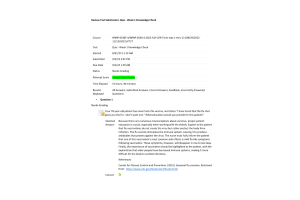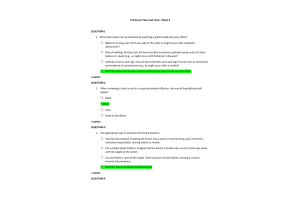NRNP 6540 Week 11 Final Exam
- $45.00
- Question: How does women’s anatomy make them more susceptible to UTIs?
- Question: The primary endocrine disorders affecting women are diabetes mellitus and:
- Question: A common prenatal care model in which women have their first visit with one provider and then subsequent visits in a group setting is called:
- Question: When is round ligament pain most likely to occur in pregnant women?
- Question: Optimal weight gain during pregnancy is based on the woman’s pre-pregnant BMI and:
- Question: In the formula to estimate gestational age, woman are considered pregnant from:
- Question: Gender differences in heart disease can be found in:
- Question: What distinguishes pyelonephritis from cystitis?
- Question: What has changed in terms of recommended antibiotic treatment for uncomplicated lower UTIs?
- Question: Carbohydrate intolerance and increased insulin resistance first recognized in pregnancy is known as:
- Question: All except which of the following are important historical questions for a 29-year-old woman in clinic for right-sided weakness?
- Question: When can relief from pregnancy induces nausea and vomiting be expected?
- Question: What is a common cause of leg cramps during pregnancy?
- Question: What is the leading cause of first-trimester maternal death?
- Question: What do current theories suggest as to how cranberry products can reduce UTIs?
- Question: Screening for hyperlipidemia is recommended to begin at what age for women with no risk factors?
- Question: Without treatment shortly after birth, as many as 90 percent of infants born to hepatitis B– infected mothers will:
- Question: After how many weeks’ gestation is a pregnancy loss considered a fetal death or stillbirth?
- Question: What is the general goal of surgical treatment for stress UI?
- Question: What is more likely to occur in women with female genital cutting?
- Question: What is an indication of the second stage of labor?
- Question: How are pregnancy-related DHA (docosahexaenoic acid) needs best met?
- Question: Qualitative urine testing for hCG (human chorionic gonadotropin) can be done reliably
- Question: What is the most common cause of death in women in the United States?
- Question: What is the most common cause of medical complications in pregnancy?
- Question: What is the term for a postpartum disorder in which bacteria ascend from the lower genital tract and infect the uterus?
- Question: At what time during pregnancy does nausea typically occur?
- Question: What is considered to be a common trigger of psoriasis?
- Question: Any woman with a complicated cystitis or symptoms of upper tract disease needs a urine culture and:
- Question: What is a potential benefit of circumcision?
- Question: How does the third stage of labor end?
- Question: What is the most common disorder leading to hyperthyroidism?
- Question: The majority of early pregnancy losses are due to:
- Question: What can be used as a space-filling device, replacing normal pressure on the vaginal walls when levator ani support is unreliable?
- Question: What is the term for stimulation of the uterus by an external agent to enhance uterine contractions after labor has started?
- Question: What should be addressed during late postpartum maternal evaluation (weeks 2–6)?
- Question: Which of the following is a predictor of impending preterm birth?
- Question: What is important to consider when vaginal bleeding occurs during the first trimester?
- Question: What is significant about cytomegalovirus (CMV)?
- Question: What step can a clinician take to learn more about any chemicals used in a woman’s workplace?
- Question: What is the most typical schedule of prenatal care in the first 28 weeks of pregnancy?
- Question: What significantly increases the risk of hypertension in women?
- Question: What is the potential danger of a fetus born through meconium-stained amniotic fluid?
- Question: What was the reason that prenatal care began in the early 1900s?
- Question: What is the most common type of UTI that affects women?
- Question: Fever associated with pyelonephritis will usually resolve within how many hours oftreatment with antibiotics?
- Question: How can hormonal influences during pregnancy cause backache?
- Question: What tends to cause acne in adolescence?
- Question: In order to maintain continence bladder pressure must be
- Question: What is a contributor to the increased incidence of heartburn during pregnancy?
- Question: When completing this quiz, did you comply with Walden University’s Code of Conduct including the expectations for academic integrity?


















